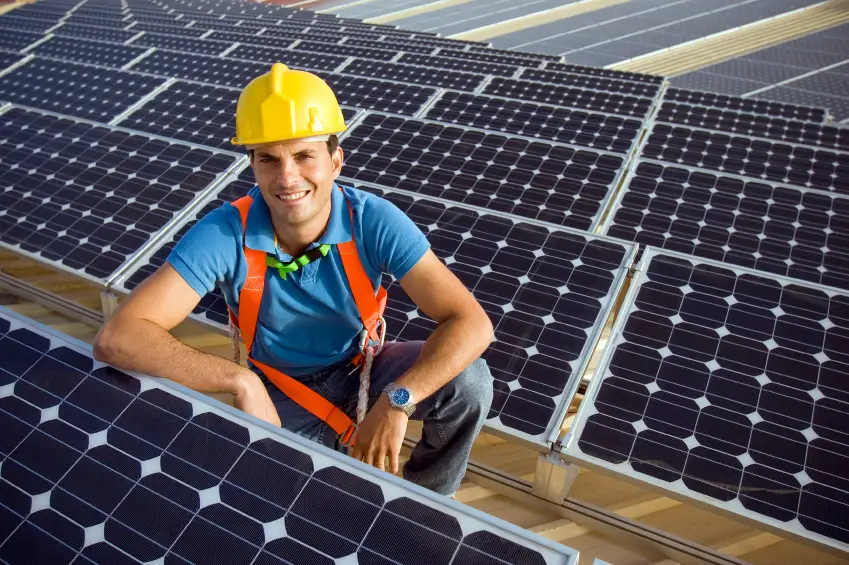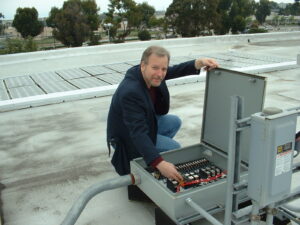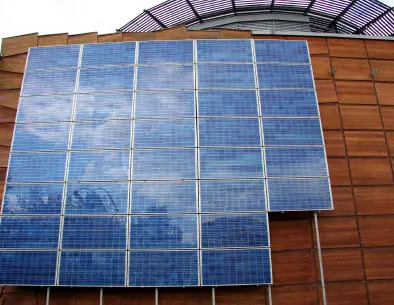
WHAT IS A COMMERCIAL SOLAR ELECTRIC SYSTEM?
, a commercial solar electric system generates power for your business by converting sunlight into electricity. Although your primary power source will continue to be your existing electric utility, whatever power your photovoltaic (PV) system generates will be used first, reducing, even eliminating, the need for you to pay for electricity. If your system produces more electricity than you are using, excess electricity will flow back into the electric grid, consequently spinning your meter backward. This supports your community, and you will also receive credits on your electric bill for these contributions. This is called ‘net metering.’

WHY SHOULD I BUY A SOLAR ELECTRIC SYSTEM FOR MY BUSINESS?
Return on Investment: With federal tax credits, federal grants for businesses using solar power, available State incentives, and a five-year accelerated depreciation of the system value, the return on investment of an extensive solar power system has never been better. We can help determine the ROI of a solar electric system for your business.
Offset Higher Priced Tiers
Most energy companies bill customers on a tiered-rate schedule with between 3 and 5 tiers of rates. The first energy consumed monthly is typically billed at the lowest cost tier. As more energy is consumed, customers move into higher tiers with a higher cost per kilowatt-hour. Solar electric systems help to offset usage in the higher-priced tiers. In addition, “demand charges,” which occur when you exceed certain peak usage levels, can be mitigated.
Control your power costs: With utility rates rising yearly, a solar electric system can stabilize your electricity costs. After the system has paid for itself, you are either producing free power or lowering the costs of the electricity you buy from the utility.
Green Marketing: Installing a solar electric system is a great way to show your customers you “walk the walk” and care about the environment. You can efficiently minimize your business’s carbon footprint and market that information to green-savvy customers. If your business does not require much electricity, it could become carbon neutral with a solar power system that meets 100% of its needs.
Time for a new roof? The very best time to install a new solar electric system is when you are putting on a new roof. The cost of your system can be dramatically reduced by working with your roofing contractor to install solar array supports on your underlying building structure. They will seal the supports and warranty their installation for any leaking.
Our Typical Customer
Our Company installs commercial solar systems in the following:
• Office buildings
• Warehouses
• Light manufacturing
• Hotels/motels
• Wineries
• Golf resorts & clubhouses
• Banks
• Pharmacies
• Auto Repair Shops
• Community Centers
• Schools
• Municipal Facilities
HOW DOES A SOLAR ELECTRIC SYSTEM WORK?
Photovoltaic cells are connected to form units called modules. Modules are then connected to form larger units called solar arrays.
An inverter converts the electricity collected by the solar array from direct current (DC) to alternating current (AC), which can be used as a power source and fed back into the grid.
The clean, renewable energy generated by your solar electric system can power lighting, computers, air conditioning, and any other daily electrical loads in a building. Surplus electricity generated by  the solar array flows back into the regional utility grid for use by other customers. Your utility would provide power as usual at night and during the day when you use more electricity than your solar system produces. If a roof-mounted system is impractical, a system can also be mounted on the ground.
the solar array flows back into the regional utility grid for use by other customers. Your utility would provide power as usual at night and during the day when you use more electricity than your solar system produces. If a roof-mounted system is impractical, a system can also be mounted on the ground.
Solar electric power works very well for business applications in the New York area. A south-facing roof is best, but panels can be mounted on the west or east-facing roofs and still provide significant power.
Solar electric systems produce electricity on both sunny and cloudy days. At night, your utility company provides the power. Under a light, overcast sky, panels might produce about half as much as under a full sun. We will calculate your system’s generation and your Company’s payback using weather and sunshine data over the past several years.
The size of your system is determined by many variables, including electrical usage, the size, angle, and orientation of your roof, how much of the roof area is shaded, available investment funds, and federal, state, and local incentives, among other things. To approximate how many panels you need for your business, multiply your daily electrical demand in kilowatt-hours by 0.25. The number of kilowatt-hours represents the size of the solar array you will need in kilowatt-hours.
A solar electric system will not directly provide heat or hot water to your business. Our solar electric systems are designed to provide electricity to run your lights, computers, machinery, appliances, and other electrical devices used in your business.
SOLAR ELECTRIC SYSTEM INSTALLATION AND MAINTENANCE
These systems require little to no maintenance. The occasional necessary rinse to remove dust is often satisfied by average rain. Our solar panels and roof mounting systems can withstand high winds, snow, and hail with no problem… even earthquakes, when required. A solar electric system is not adversely affected by cold weather because it is light and not heat that causes solar cells to generate electricity; solar panels produce more power when cold.
A solar electric system and all components will typically operate and are guaranteed by the manufacturer for 20 years. The primary solar module has no moving parts and can last more than 30 years.
Web-based or local Monitoring systems can visually indicate performance and let you know if service is needed.
Get Started
Call today or schedule a free evaluation to see how a commercial solar electric system can benefit your business.